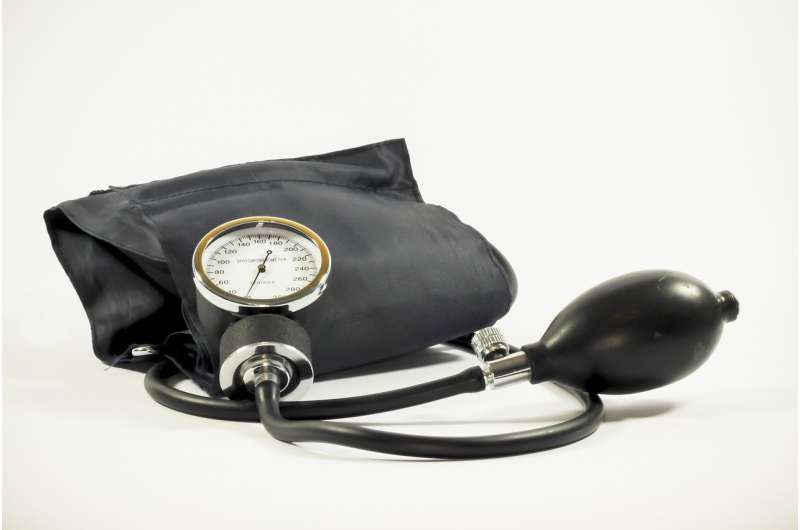Some health care professionals use outdated guidelines to screen and diagnose hypertension

A survey revealed that the majority of health care professionals are not following current, evidence-based practices to screen and diagnose hypertension, and a separate study found that using an automated, office blood pressure (AOBP) monitor may not be optimal in determining a new case of hypertension, according to new research to be presented Sept. 10-13, 2020, at the virtual American Heart Association's Hypertension 2020 Scientific Sessions.
Blood Pressure Checks And Diagnosing Hypertension: Provider Knowledge, Beliefs And Practices (#P163)
The 2017 American Heart Association/American College of Cardiology Guideline for the Prevention, Detection, Evaluation, and Management of High Blood Pressure in Adults recommends the use out-of-office blood pressure measurements such as ambulatory blood pressure monitoring (ABPM) before making a new diagnosis of hypertension. Ambulatory monitoring involves a patient wearing a cuff that automatically checks blood pressure every 30 minutes during the day and every 60 minutes at night. However, researchers in this study note this approach is not common in routine practice.
Researchers developed a survey for health care professionals to evaluate their knowledge, beliefs and practices regarding current hypertension diagnostic tests. In total, 282 professionals across 10 primary care medical centers responded. Survey results indicate:
- 79% of professionals believe that blood pressure measured manually with a stethoscope is a very or highly accurate way to assess blood pressure;
- More than 96% of health care providers reported that they always or almost always relied on clinic blood pressure measurements in making a new diagnosis of hypertension;
- However, 60% of physicians would prefer using ABPM if available.
"We were surprised that blood pressure measurements taken manually with a cuff and stethoscope was the most trusted method, and most often utilized when making a new diagnosis of hypertension," said Beverly Green, M.D., M.P.H., lead author of the study, a family physician at Kaiser Permanente Washington, a senior investigator at Kaiser Permanente Washington Health Research Institute, associate clinical professor at the University of Washington School of Medicine. "Additionally, most physicians and advanced practitioners thought the threshold for high blood pressure for 24-hour ambulatory or home blood pressure monitoring was >140/90 mm Hg, which does not reflect the updated new ACC/AHA [issued in 2017] or prior hypertension guidelines."
According to the American Heart Association/American College of Cardiology Guideline for the Prevention, Detection, Evaluation, and Management of High Blood Pressure in Adults, hypertension should be defined as ?130/80 mm Hg. Researchers noted that this study began before the updated ACC/AHA guidelines were released in 2017, and at that time, ?140/90 mm Hg was the appropriate criteria. Limitations to this study include a small sample size, yet researchers note that having survey respondents from multiple centers helps to strengthen the sample.
Automated Office Blood Pressures For Making A Diagnosis Of Hypertension And The Effect Of Attendance And Rest Time (#MP35)
In a second study, Green and colleagues examined how using an automated office blood pressure (AOBP) monitor, an automated monitor is used to take three to five blood pressure readings that are then averaged, affects the results and found that AOBP led to fewer hypertension diagnoses.
"Blood pressure varies throughout the day for all people. We focused on investigating whether having an attendant in the room matters and to determine the impact of varying amounts of rest times on blood pressure using automated readings," said Green. "We also evaluated the performance of AOBP monitors in making a new diagnosis of hypertension compared to 24-hour ambulatory blood pressure, which is considered the gold standard for deciding whether a patient has hypertension or not."
The study included 130 adults with high blood pressure (defined in this study as >140/90 mm Hg) who had no prior hypertension diagnosis or treatment. All participants completed 24-hour ambulatory blood pressure monitoring (APBM) directly before starting the study, and more than 60% tested positive for hypertension based on the ABPM measures.
Participants were randomized to one of two groups: those who received AOBP with an attendant first and unattended second, and those who received unattended AOBP first and with an attendant second. The AOBP measurements were performed after five minutes of rest and again after 15 minutes.
Results showed that having an attendant in the room did not impact AOBP readings. Lack of resting prior to AOBP did result in a significantly higher blood pressure readings than the average daytime 24-hour ambulatory blood pressure. In addition:
- AOBP correctly identified those with and without hypertension 67% of the time;
- 21% of hypertension diagnoses were missed; and
- 12% of participants were over diagnosed.
"These findings indicate AOBP readings might not be the optimal way to rule in or rule out a new diagnosis of hypertension. We expected blood pressure would go down after resting more than 15 minutes, and we were surprised that it did not," said Green. "When there is a question of whether blood pressure is high or normal, getting more blood pressure measurements, either by at-home testing or by getting a 24-hour ambulatory monitoring test, is likely to lead to better decision-making."
In this study, an elevated blood pressure was defined as a blood pressure reading >=140/90 mm Hg. According to the 2017 American Heart Association/American College of Cardiology Guideline for the Prevention, Detection, Evaluation, and Management of High Blood Pressure in Adults, hypertension should be defined as >=130/80 mm Hg. Limitations to this study include a small sample size.
More information: Paul K. Whelton et al. 2017 ACC/AHA/AAPA/ABC/ACPM/AGS/APhA/ASH/ASPC/NMA/PCNA Guideline for the Prevention, Detection, Evaluation, and Management of High Blood Pressure in Adults: A Report of the American College of Cardiology/American Heart Association Task Force on Clinical Practice Guidelines, Hypertension (2017). DOI: 10.1161/HYP.0000000000000065




















